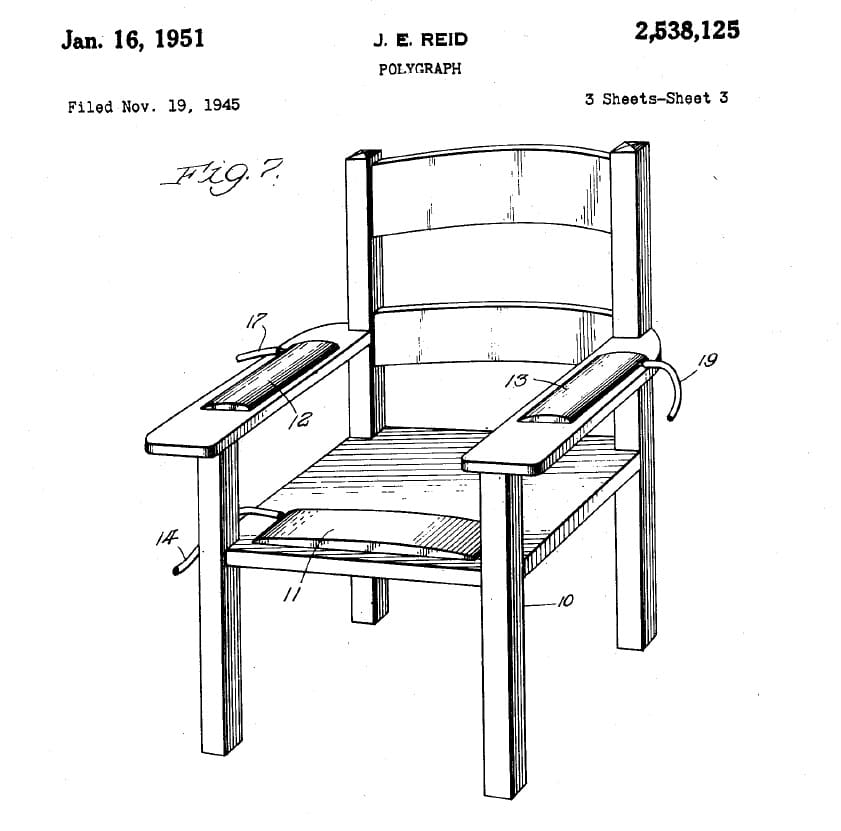
Polygraph. John E. Reid, inventor. U.S. Patent No. 2,538,125. 16 January 1951 (More: John E. Reid, inventor. U.S. Patent No. 2,538,125. 16 January 1951),
In the annals of polygraphy, a significant milestone was reached when American researcher, lawyer, and polygraph expert John Reid (1910-1982) turned his attention towards the creation of a specialized polygraph chair. This innovative endeavor aimed not only at detecting the concealed movements of individuals undergoing the lie detector test but also at enhancing their comfort level during the examinations.
The journey began in 1945 when John Reid embarked on a pioneering project to monitor muscle activity in the forearms, thighs, and feet of subjects. He ingeniously utilized metal bellows integrated into the armrests and seat of what was then termed the “printing chair.” This was a groundbreaking approach in the realm of polygraph testing, marking a departure from traditional methods.
Donald J. Krapohl, a notable figure in the field of polygraphy, highlighted in 2013 that John Reid’s innovative chair, equipped with sensors to trace hidden movements, laid the foundation for what would evolve into the modern polygraph chair. More importantly, it heralded a new era in detecting countermeasures employed by individuals undergoing the test, thereby significantly bolstering the effectiveness and reliability of polygraph examinations.
The polygraph chair devised by Reid in 1945 represented the first concerted effort to systematically record and analyze the physical movements of test subjects. This was a crucial development, as it directly contributed to enhancing polygraph examiners’ ability to discern truth from deception with greater accuracy.
Adding to its historical significance, a photograph of the first polygraph chair developed by J. Reid in 1945 stands as a testament to this groundbreaking invention. It was in 1951 that Reid, in recognition of his monumental contribution to the field of polygraphy, secured a patent for both the polygraph chair and the polygraph system he developed. This chair not only symbolizes a pivotal moment in the history of lie detection but also underscores the innovative spirit of John Reid, whose contributions have indelibly shaped the landscape of polygraph testing.
What makes a polygraph chair essential for polygraph examiners?
- It enables examiners to closely monitor the test subject’s movements.
- It provides a comfortable setting for the test subject, ensuring they remain still and focused on the examiner’s questions during the test.
- It allows the detection of any movement by the test subject that could affect physiological responses, crucial for identifying attempts to counteract the polygraph test.
The standards for conducting polygraph tests were outlined in the international standards ASTM E2386-04(2017) “Standard Practice for Screening Tests in Psychophysiological Detection of Deception” and ASTM E2062-11(2017) “Standard Guide for Conducting Psychophysiological Detection of Deception (PDD) Examinations.”
According to ASTM E2386-04(2017), established in 2004, the environment for a polygraph test must be free from distractions that could impair the subject’s concentration on the questions. The testing area should be isolated from external noise and disruptions (Section 3.1 Practices).
The 2011 standard, ASTM E2062-11(2017), reiterated the need for a non-distracting testing environment to maintain the test subject’s focus on the questions. The examination area must be shielded from external noise and interruptions, although this noise protection requirement may be waived for demonstrations, training sessions, and similar activities (Section 3.1 of the Guidelines).

